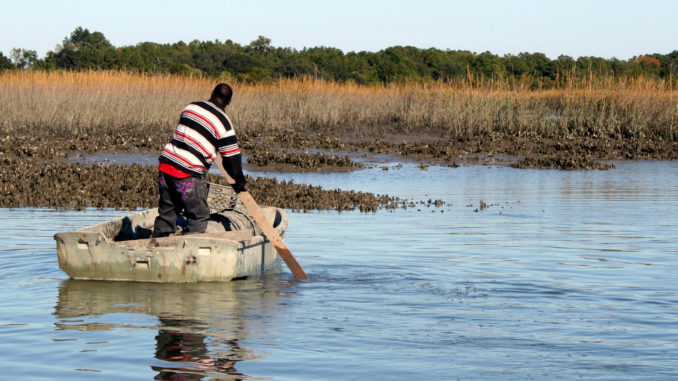
Bought or picked, they’re a winter delicacy
In the middle of winter, many people stay indoors on cold evenings, only venturing out when it is absolutely necessary. In South Carolina however, people often venture happily outside for the promise of something warm and delicious: steamed oysters. Cold weather, good friends, and fresh, steamed oysters are a South Carolina tradition.
There is more to harvesting oysters than just going out to a random oyster bed and picking them up. The S.C. Department of Natural Resources has designated public shellfish grounds and state shellfish grounds and provides maps showing locations of these grounds. Recreational harvest only is allowed on public shellfish grounds; state shellfish grounds are open for commercial and recreational or commercial only harvest. The SCDNR also sets the season on oysters based on when they are safe to harvest and consume. Bacteria levels in oysters are much higher when the water temperature warms above 80 degrees, so they should be avoided during the warmer months. Traditionally, only the months containing an “r” are considered safe months for oysters, but the season in South Carolina usually doesn’t open until October and closes in May.
Ray Hightower, a Ladys Island resident and oyster connoisseur, is particular about which oysters he chooses.
“I look for oysters that are round and wide at the mouth and skinny at the hinge; these oysters will be the biggest,” he said. “Clusters of oysters made up of mostly long and skinny ones should be avoided.”
Hightower uses a short piece of half-inch rebar to separate clusters of big oysters from clusters of smaller ones. so he only takes away the oysters he feels are ready for harvest.Also, he prefers to target oysters that are under water for the longest amount of time.
“I like to wait until the tide is pretty far down and go after oysters at the edge of the water,” he said. “The longer the oyster is under the water, the plumper and juicer it will be.”
Harvesting oysters is hard work and a dirty job, not to mention tough from a boat. Many people forgo the harvesting process altogether and buy their oysters from commercial harvesters and local businesses.
Jimmy Skinner of Edisto Seafood in Edisto Beach lists a few things people should look out for when buying oysters.
“Cleanliness is important when shopping for oysters; there shouldn’t be much mud on the shells,” he said. “Also, check the tag on the bag of oysters, because oysters should be consumed within 10 days of harvest, and a good bushel of oysters should weigh approximately 45 pounds.”
Not all oysters available at grocery stores and fish markets are South Carolina oysters; this is especially true further inland, so be sure to ask before buying.
“People who have had our local clusters will tell you our oysters taste better than oysters from out-of-state, and buying South Carolina oysters supports your local economy,” Skinner said.
Plucked from the bed or purchased from the market, the best thing about oysters is eating them, and there is no better way to feed a crowd than to steam up a bunch at a time and laying them on a waste-high table where people can grab them up and start shucking.
Oysters touched by steam only are the tastiest, and water in the steamer should stay well below the oysters.
“Oysters should be steamed only until they barely start to open, and then served with cocktail sauce and garlic butter for dipping, cold beer, and good friends,” Skinner said.
Knives made especially for opening oysters make getting into the shell much easier, and a gloved hand makes hot oysters easier to grab and greatly reduces the risk of getting cut by a sharp shell.
Hightower uses a unique holder that protects the hand from sharp shells while it drains away hot juices from the holder. It is made from a rubber inner tube; one tube can make several holders. An oval piece is cut from the rubber tube just slightly wider than the average person’s hand and a few inches longer. A hole big enough to slide a hand into is cut in one end so it can be placed over the hand and held in place at the wrist. It’s easier to keep clean than a glove and much less likely to smell funky on the next day.
Nothing can draw a crowd in cold weather quite like an oyster roast. For a traditional Lowcountry experience add a big outdoor fire and a little music to the mix. Hot, steamed oysters combined with good friends and family are a great way to break up boring days spent indoors hiding from the cold.





Be the first to comment